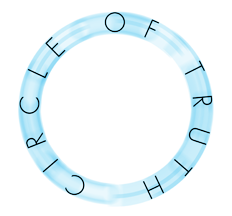Christopher Monger Essay
#338 Billy Al Bengston (Visiting Painting)
#39 Christopher Monger (Response Painting)
So I stare at the painting that has arrived in my home. A small white circle sits on the bottom edge of a pale, slightly metallic ground. My immediate reaction is that it is an unwanted guest: This painting is the antithesis of my work.
Firstly I approached it compositionally, breaking down the spaces as one would break down an Old Master, finding the construction lines. I draw them on a sheet of paper. I was left with something that looked like a bad Diebenkorn. Next, I tried to look past its simplicity, searching for some literal meaning. I was suddenly terrified that everyone had painted THE CIRCLE OF TRUTH and I loathed such an idea. Maybe I should return that abstract flat circle to something tangible: The setting sun, an eye, a car wheel, the earth, an electron, a nipple, a jar lid, a flying saucer – the list was endless, and boring. It would be a meaningless dull visual pun. I spent a lot of time thinking about it, I didn’t know how to react to it… It was just making me mad.
So I did what I do whenever I’m stuck in my work, whether I’m writing or painting: If something doesn’t work, I try the opposite: A scene refuses to get funnier? Make it dramatic. A painting looks too controlled? Drag the damn thing across the floor. It’s a tool that’s served me well, helping me to make creative leaps, allowing everything to breathe and be full of possibilities. With this is mind I made a list of words that described the painting I had in front of me – and decided to make something that was its polar opposite. Whereas it is cool, my painting would be hot. Where it is controlled, mine would be chaotic. Where it is tasteful, mine would be tasteless. Where it has a definitive focus, mine would refuse to allow the eye a place to rest. Where it is flat, mine would have utterly ambiguous depth. Where as the white circle sits on the edge, even the edge of mine would be ambiguous, being able to be read as either foreground or background. It was a long list.
To this end I gave the painting a ground of a truly horrid, dull camouflage green. Over that I skimmed a really atrocious raw-meat pink, and set to work, making marks and negating them. I used brushes, palette knives, sponges, the ends of old pencil and crayons, bits of cardboard – anything that would carry paint and make a messy mark.
I pity the poor bastard who gets mine. He or she will probably end up painting a white circle on a plain ground. And that’s OK.



